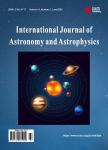Kruskal Coordinates and Mass of Schwarzschild Black Holes: No Finite Mass Black Hole at All
Kruskal Coordinates and Mass of Schwarzschild Black Holes: No Finite Mass Black Hole at All作者机构:Theoretical Astrophysics Section Bhabha Atomic Research Centre India
出 版 物:《International Journal of Astronomy and Astrophysics》 (天文学与天体物理学国际期刊(英文))
年 卷 期:2012年第2卷第4期
页 面:236-248页
学科分类:07[理学] 0701[理学-数学] 070101[理学-基础数学]
主 题:Kruskal Coordinates Black Hole Black Hole Alternatives Eternally Collapsing Object
摘 要:When one presumes that the gravitational mass of a neutral massenpunkt is finite, the Schwarzschild coordinates appear to fail to describe the region within the event horizon (EH), of a Schwarzschild Black Hole (SBH). Accordingly, the Kruskal coordinates were invented to map the entire spacetime associated with the SBH. But it turns out that at the EH (Mitra, IJAA, 2012), and the radial timelike geodesic of a point particle would become null. Physically this would mean that, the EH is the true singularity, i.e., M = 0, and this zero mass BH could only be a limiting static solution which must never be exactly realized. However, since in certain cases , here we evaluate this derivative in such cases, and find that, for self-consistency, one again must have at the EH. This entire result gets clarified by noting that the integration constant appearing in the vacuum Schwarzschild solution (and not for a finite object like the Sun or a planet), is zero (Mitra, J. Math. Phys., 2009). Thus though the Schwarzschild solution for a point mass is formally correct even for a massenpunkt, such a point mass or a BH cannot be formed by physical gravitational collapse. Instead, physical gravitational collapse may result in finite hot quasistatic objects asymptotically approaching this ideal mathematical limit (Mitra & Glendenning, MNRAS Lett. 2010). Indeed “the discussion of physical behavior of black holes, classical or quantum, is only of academic interest (Narlikar & Padmanbhan, Found. Phys. 1989).



